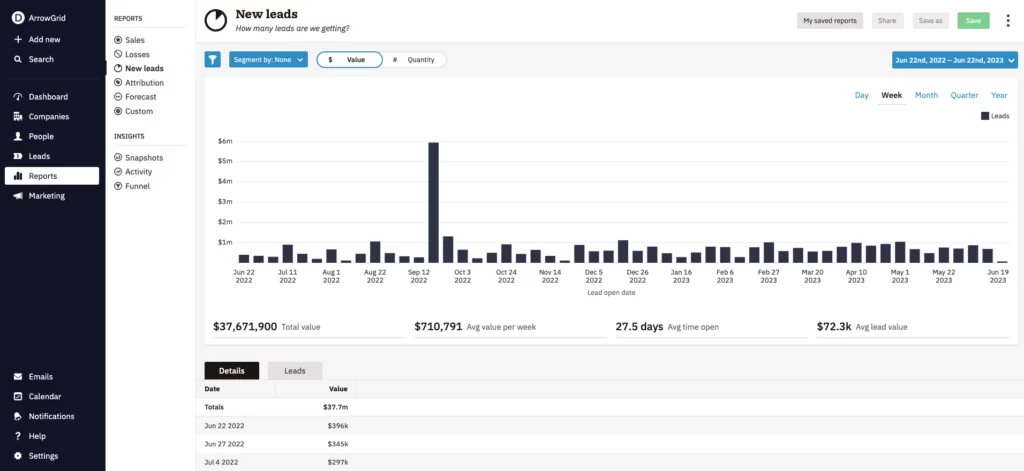
Every business’s sales pipeline is different, but one thing they all have in common is that they take people from prospective leads to paying customers.
As a manufacturing company, a steady customer base is key to your business’s growth, and the best way to maintain that customer base is through sales pipeline management.
Today we’re discussing how to manage a sales pipeline for a manufacturing company by looking at five management tactics you can employ today. Keep reading to learn more about each one and how they can help your sales pipeline (and your manufacturing company) thrive.
Managing and maintaining a manufacturing sales pipeline starts with defining the stages of the pipeline itself. By breaking the pipeline down into different stages, you can better track your leads as they enter and exit each stage.
Manufacturing companies’ sales pipelines will vary depending on what they manufacture, who their target customers are, and their sales goals. Below is an example of what a manufacturing sales pipeline might look like:
Lead scoring is a helpful method for managing leads coming in through your manufacturing sales pipeline. Essentially, lead scoring is when businesses assign numerical values to leads based on how likely they are to convert.
Rather than spending valuable time and effort trying to convert a lead that’s not likely to convert, lead scoring allows businesses to prioritize the most important leads by identifying those that are more valuable. In other words, you’re putting your efforts toward leads that are interested in your products.
Without lead scoring, a few things can happen. As we already mentioned, you can waste time, effort, and money on leads who aren’t interested in your products. But while trying to please low-value leads, you could also lose high-value leads who are interested in your company but got tired of waiting for you to contact them.
Attracting leads to your manufacturing sales pipeline isn’t a one-and-done deal. It takes regular marketing and communication efforts to move leads through each stage of your sales pipeline and get them to convert.
How you reach out to your leads depends on who they are and how they interact with your company. If they subscribed to your email list, you can regularly send emails reminding them of what you have to offer or reminding them to check back on a product they may have viewed on your website.
Lead nurturing is an important part of maintaining a manufacturing sales pipeline because it helps you nudge your leads closer to taking the next step toward becoming a customer. Without it, your valuable leads could slip through the cracks.
There’s plenty of manufacturing software out there, from enterprise resource planning (ERP) software to quality management systems (QMS), but a customer relationship management (CRM) platform should be at the top of your list.
A CRM collects, stores, and organizes customer data in one centralized location for easy access. On top of that, CRMs like Nutshell come equipped with in-depth reporting and analysis capabilities so manufacturing businesses like yours can gain a comprehensive view of your customers (plus, an edge over your competitors).

CRM reports give deep insights into how your sales pipeline is performing, from where leads are coming in to how they’re moving through each stage. A CRM gives you customized reports about your leads and customers, making it a worthy investment for your manufacturing sales pipeline management strategy.
Finally, one of the best ways to successfully manage a sales pipeline for a manufacturing company is to consistently evaluate data on your leads and customers and use it to optimize your sales pipeline.
The data you collect with your CRM can help you understand how your leads and customers interact with your brand and how you can adjust your pipeline to fit their needs.
Now that you know how to manage your manufacturing sales pipeline, it’s time to get started. If you asked us, we’d say you should start with integrating a CRM into your sales pipeline management strategy.
Now that you know how to manage your manufacturing sales pipeline, it’s time to get started. And the best place to start is integrating a CRM into your sales pipeline management strategy.
Nutshell is a user-friendly CRM platform trusted by over 1,000 manufacturing companies. Complete with dozens of software integrations, automation tools, contact management features, and more, Nutshell makes managing your manufacturing leads and sales pipeline simple and stress-free.
Learn more about what Nutshell CRM can do for your manufacturing business by checking out a live demo or starting a 14-day free trial today!
Join 30,000+ other sales and marketing professionals. Subscribe to our Sell to Win newsletter!
 Email & Calendar Sync
Email & Calendar Sync




Nutshell is easy to use with enterprise level features and no hidden fees.
See for yourself!